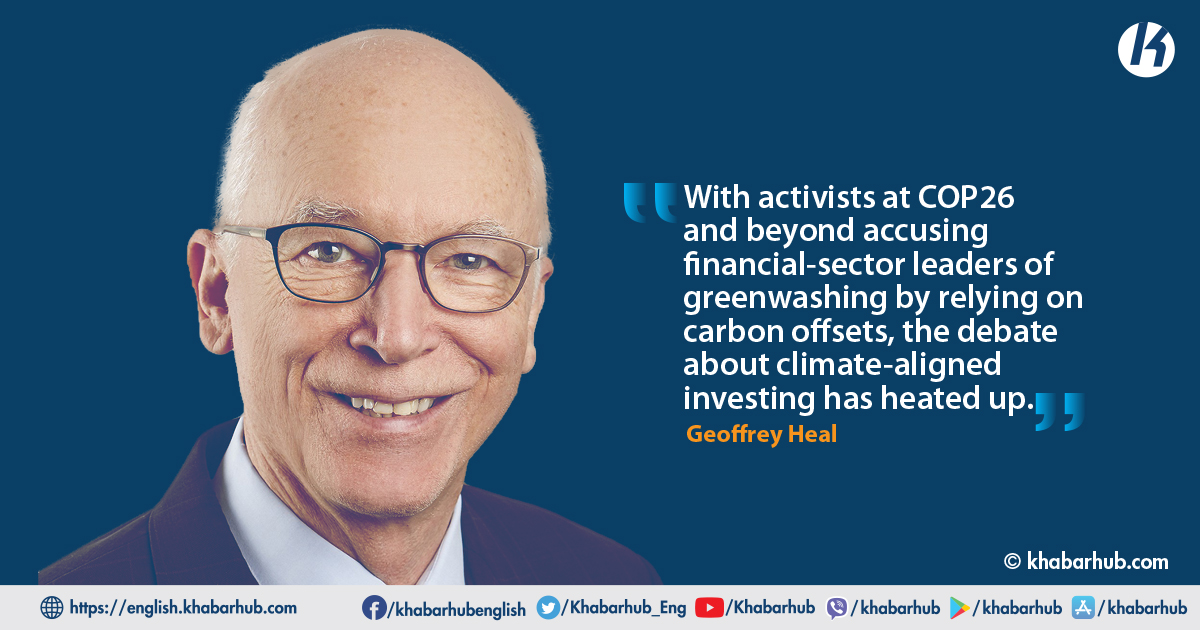In the run-up to this year’s United Nations Climate Change Conference in Glasgow (COP26), a growing number of companies hopped on the sustainability bandwagon, declaring commitments to achieve carbon neutrality – net-zero carbon-dioxide emissions – by mid-century.
And among the many ambitious announcements to come out of COP26 is that almost 500 financial-services firms have “agreed to align $130 trillion – some 40% of the world’s financial assets – with the climate goals set out in the Paris agreement, including limiting global warming to 1.5°C.”
But many commentators have been skeptical about such proclamations, suggesting that they amount to greenwashing.
Critics point to corporations’ heavy reliance on “offsetting,” which has become an increasingly important – and controversial – issue in the broader climate debate.
So great is the confusion about what is real and what is not that the Taskforce on Scaling Voluntary Carbon Markets, led by UN Special Envoy for Climate Action and Finance Mark Carney, has established a new governance committee to review corporate emissions pledges.
The skeptics are right to be concerned about the use of offsets. The world needs to get to net-zero by mid-century, and it cannot do that with offsets.
Companies buy offsets precisely so that they can continue emitting greenhouse gases (GHGs) while claiming that their emissions are zero, net of the offsets. The very existence of an offset means that the purchaser’s emissions are not zero.
Scope one refers to emissions that arise from a company’s own operations, whereas scope two applies to those associated with the production of electric power purchased by the company, and scope three to those arising from other parts of the supply chain, particularly from the consumption of the product.
But not all offsets are alike. The critics focus on offsets in which one company or country pays another to reduce emissions and then claims the reduction as its own.
This is the kind of offset that cannot be allowed if the world as a whole is to get to zero emissions. There is a place, however, for offsets generated by removing GHGs from the atmosphere, for example by direct air capture or forest growth.
If a company emits 100 tons of CO2 and then removes the same amount, its net emissions really are zero. If all companies do this, the world as a whole will achieve net-zero emissions.
True, the recourse to forestry requires a cautionary note. Growing trees raises issues of both additionality and permanence – additionality because it is hard to be sure that the forest growth would not have occurred anyway, and permanence because there is a risk that the forest will burn, a problem that has grown more visible and severe in recent years.
Still, offsets can play a positive role. The costs of reducing GHG emissions, and the willingness and ability to pay for such reductions, vary greatly from country to country, depending on the sources of its emissions and its stage of development.
Some countries may not be willing or able to pay for an expensive reduction in emissions at home but could still pay for less costly reductions abroad.
When this happens, an offset market can facilitate a reduction in emissions that would not otherwise have occurred, or that would not occur without a policy that penalizes CO2 emissions.
In this case, offsets may be useful at least in moving the world closer to net-zero emissions. But to reach the finish line, they will have to be phased out at some point. There ultimately is no place for offsets in a zero-emissions world.
In the meantime, policymakers and business leaders would do well to attend to a related issue that has been neglected: the failure to distinguish between so-called scope-one, scope-two, and scope-three emissions.
Scope one refers to emissions that arise from a company’s own operations, whereas scope two applies to those associated with the production of electric power purchased by the company, and scope three to those arising from other parts of the supply chain, particularly from the consumption of the product.
Clearly, there is potential for massive double counting here if one adds up all the emissions across companies. If my company purchases electricity from a local utility, the associated emissions are scope two for me and scope one for the utility.
Plan on phasing out offsets over the long run. And continue to look for opportunities to remove GHGs from the atmosphere, as these reductions can still be counted against your own scope-one emissions.
If Exxon sells jet fuel to American Airlines for use in Boeing aircraft, the emissions are scope three for Exxon and Boeing, and scope one for American Airlines.
These emissions are counted three times, which is anathema to any competent accounting system. Every scope-two or -three emission is someone else’s scope-one emission.
Fortunately, such confusion is avoidable. If every company has reduced its scope-one emissions to zero, aggregate corporate emissions will be zero.
It therefore makes sense for every company to focus only on this factor. If scope-one emissions are brought to zero, scope-two and scope-three emissions will take care of themselves.
This should help to simplify the general policy guidance and instructions given to companies: Focus on reducing your scope-one emissions.
Plan on phasing out offsets over the long run. And continue to look for opportunities to remove GHGs from the atmosphere, as these reductions can still be counted against your own scope-one emissions.
(Geoffrey Heal is Professor of Social Enterprise at Columbia Business School)
Copyright: Project Syndicate









Comment